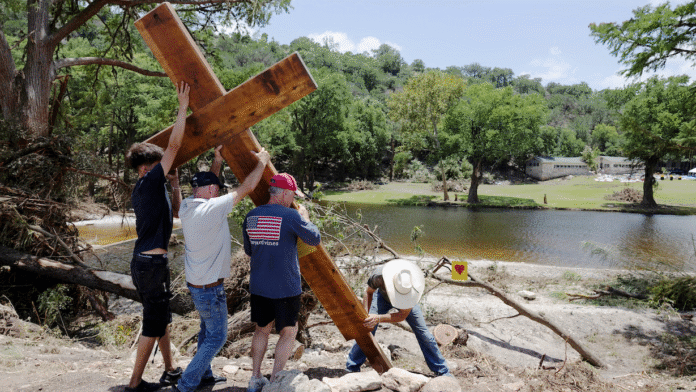- Over 100 people remain missing two weeks after devastating Texas floods that claimed at least 135 lives.
- Rescue teams face challenges due to damaged infrastructure while searching flooded areas by air and ground.
- Public outcry grows over preparedness and response, sparking calls for improved flood defenses and long-term planning.
It’s been over two weeks since the catastrophic floods swept through central Texas, and the grim reality remains: more than 100 people are still unaccounted for. The torrential waters, unleashed around the July 4 holiday, tore through riverside homes, campgrounds, summer camps, and RV parks with relentless force. At least 135 lives have been confirmed lost, but hope clings on amid ongoing search and rescue operations.
The scene across affected areas is one of heartbreak and chaos. Families cling to the last threads of hope, scanning the skies for the familiar thrum of helicopters—Black Hawks and medical choppers—swooping low to search for survivors. Emergency crews work tirelessly, navigating treacherous floodwaters and debris, pushing the limits of their resources to bring closure to families and save those still trapped.
Floodwaters Devour Communities and Shatter Lives
The flooding struck with brutal suddenness. Central Texas, usually vibrant with summer activity, transformed overnight into a landscape of devastation. Campgrounds that once echoed with laughter became watery graves, while rivers that typically provide calm and recreation turned into raging torrents. Entire neighborhoods were swallowed by rising waters, leaving families stranded on rooftops or clinging to trees.
Among the hardest hit were the summer camps packed with children and counselors eager to enjoy a holiday break. In some places, the water rose so fast and furious that escape was impossible. Parents and communities still reel from the shock as they wait anxiously for news about missing loved ones.
The death toll continues to climb as recovery teams uncover more victims amid the wreckage. For every body found, dozens of families face agonizing uncertainty about the fate of those still missing.
Rescue Operations Face Harsh Challenges Amid Widespread Damage
Rescuers battle against time and the elements. The floodwaters have receded in many areas, but the destruction they left behind poses significant obstacles. Roads remain impassable, power outages hamper communication, and debris clogs waterways and streets.
Helicopter crews patrol the skies, searching for signs of life in places unreachable by boat or foot. Ground teams navigate muddy, flooded terrain to access isolated pockets where survivors may be trapped. The scale of the disaster has stretched resources thin, forcing officials to prioritize the most urgent calls for help.
Local authorities and federal agencies are coordinating efforts, but the slow pace of progress tests the patience and resolve of those waiting. Families gather at makeshift shelters and community centers, sharing information and clinging to hope even as days drag on.
Public Outcry Grows Over Preparedness and Response
As the crisis unfolds, questions have emerged about whether enough was done to prepare for such a catastrophic event. Residents and officials alike have expressed frustration with the speed and scope of the response.
Some criticize the flood warning systems and evacuation plans, pointing to gaps in communication that may have cost lives. Others highlight the vulnerability of certain communities, especially those near rivers and low-lying areas, which seemed ill-equipped to withstand such a sudden surge.
Social media buzzes with personal stories, pleas for help, and calls for accountability. Volunteers flood into the region, bringing supplies and support, while fundraising campaigns swell to aid victims and rebuild shattered homes.
Despite these efforts, many argue that Texas must confront broader challenges posed by climate change and urban development that increase flood risks. The devastating July floods have become a stark reminder of how fragile communities can be in the face of nature’s fury.
The Long Road Ahead: Recovery and Rebuilding
Even as search and rescue missions continue, the focus is gradually shifting toward recovery and rebuilding. The emotional toll on survivors, families of the missing, and rescue workers is immense. Communities face the daunting task of repairing homes, restoring infrastructure, and healing wounds both physical and emotional.
Local leaders emphasize the need for long-term planning and investment in flood defenses to prevent such tragedies in the future. Conversations about smarter land use, improved emergency preparedness, and stronger environmental protections are gaining urgency.
For those who lost loved ones, there is little solace in promises for the future. Their lives have been changed forever by this sudden, merciless flood. Memorials and vigils are held across the state, honoring those who perished and supporting those left behind.
A Call for Unity Amid Tragedy
In these dark days, the spirit of Texas shines through. Communities rally to support each other, neighbors open their doors to strangers, and countless volunteers work around the clock. The tragedy has sparked an outpouring of generosity and resilience.
Yet, with over 100 still missing, the pain and uncertainty remain raw. Every day brings new updates, sometimes heartbreaking, sometimes hopeful. The search for answers continues, propelled by determination and the unyielding human hope that no one is truly lost.
As Texas grapples with the aftermath of this disaster, the state’s resilience will be tested like never before. But if the strength and compassion witnessed so far are any indication, there is a flicker of hope amid the floodwaters — that Texas will rise again, stronger and more united.




